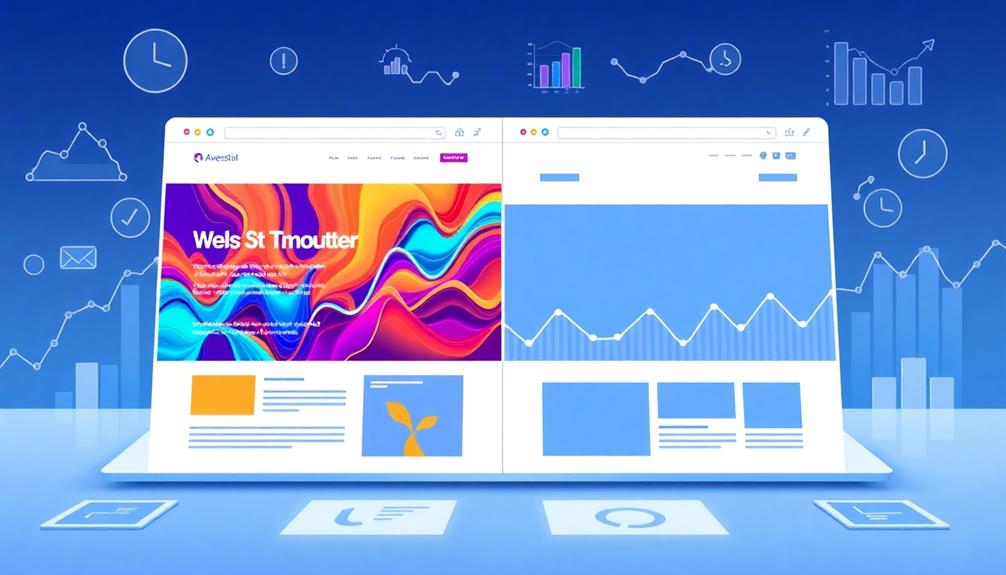To protect your small business data, use strong, unique passwords and enable multi-factor authentication for added security. Keep all your software and systems up to date to close vulnerabilities. Regularly back up your critical data and store backups securely off-site. Educate your staff about cybersecurity risks like phishing. Implement effective firewalls and antivirus tools, and restrict access to sensitive information based on roles. Following these steps helps build a solid defense—discover more ways to strengthen your security.
Key Takeaways
- Implement multi-factor authentication and strong, unique passwords for all accounts.
- Regularly update and patch software, operating systems, and security tools to fix vulnerabilities.
- Conduct frequent access audits and apply the principle of least privilege to limit data exposure.
- Back up data regularly to secure, off-site locations and verify backups’ integrity.
- Educate employees on cybersecurity best practices, including phishing awareness and safe data handling.
Use Strong, Unique Passwords and Enable Multi-Factor Authentication

To protect your small business from cyber threats, you need to use strong, unique passwords for all accounts. Effective password management is essential for maintaining account security. Avoid reusing passwords across different platforms, as this creates vulnerabilities. Instead, use a password manager to generate and store complex passwords securely. This reduces the risk of hacking and unauthorized access. Additionally, enable multi-factor authentication whenever possible. It adds an extra layer of security by requiring a second verification step, such as a code sent to your phone. Fostering a security-aware culture within your organization can further enhance your defenses against evolving threats. By prioritizing password strength and managing your credentials carefully, you markedly lower the chances of cyber attacks targeting your business data. Strong passwords combined with multi-factor authentication help safeguard your sensitive information from cybercriminals. Implementing cybersecurity best practices can further enhance your defenses against evolving threats. Incorporating security awareness training for your team can also improve overall protection. Regularly updating your systems and software is another critical component to prevent vulnerabilities that could be exploited by cybercriminals. Staying informed about the latest threats and security developments is vital for maintaining robust protections.
Keep Software and Systems Up to Date

Keeping your software and systems up to date is one of the most effective ways to defend your small business against cyber threats. Regularly applying software updates and system patches closes security gaps that hackers exploit. Ignoring updates leaves vulnerabilities open, risking data breaches. To stay protected:
- Enable automatic updates whenever possible.
- Schedule regular checks for new software patches.
- Don’t delay installing critical updates.
- Keep all operating systems and applications current.
- Regular system maintenance can help identify and address outdated components before they become vulnerabilities. Incorporating security best practices, such as timely updates, further strengthens your defenses against cyber attacks. Staying vigilant about software spoilage and ensuring your systems are current is essential to maintaining a secure digital environment. Additionally, staying informed about emerging cyber threats can help you adapt your update strategy proactively. Regularly reviewing your security protocols ensures that your defenses stay aligned with evolving cyberattack methods.
Regularly Back Up Your Data

Since updating your software helps protect against vulnerabilities, it’s equally important to guarantee your data remains safe even if a breach occurs. Regularly backing up your data ensures you can recover quickly and minimize damage. Use cloud storage solutions to create automatic backups, making data accessible and secure off-site. Before backing up, encrypt your files to protect sensitive information from unauthorized access. Implement a schedule that fits your business needs—daily, weekly, or monthly—and verify backups regularly to ensure they’re complete and functional. By combining consistent backups with data encryption and cloud storage, you reduce the risk of data loss and strengthen your cybersecurity defenses. This proactive approach keeps your business resilient, even in the face of cyber threats or hardware failures.
Educate Your Employees About Cybersecurity Risks

Educating your employees about cybersecurity risks is essential because human error remains one of the biggest vulnerabilities in any small business. When staff understand threats like phishing awareness and social engineering, you markedly reduce the risk of security breaches. Make sure your team knows how to spot suspicious emails or links, and encourage skepticism toward unknown contacts requesting sensitive information. To reinforce this, consider these steps:
- Conduct regular cybersecurity training sessions.
- Share real-world examples of social engineering attacks.
- Establish clear protocols for verifying unknown requests.
- Promote a culture of security awareness across your team.
- Incorporate sound design techniques into ongoing training to keep staff informed about evolving threats.
Implement a Robust Firewall and Antivirus Solutions

A strong firewall and reliable antivirus solutions are your first line of defense against cyber threats. Start by configuring your firewall properly to block unauthorized access and monitor network traffic. Proper firewall configuration includes setting up rules that segment your network, creating zones to isolate sensitive data from less secure areas. This network segmentation minimizes the risk of widespread damage if a breach occurs. Ensure your firewall is up-to-date and capable of filtering malicious traffic. Combine this with a reputable antivirus program that scans for malware, ransomware, and other threats in real-time. Regularly update both your firewall and antivirus software to stay protected against evolving threats. Additionally, conducting security audits can help identify vulnerabilities before they are exploited by cybercriminals and improve your overall security posture. Understanding how cybersecurity threats develop and evolve can further help you adapt your defenses proactively. Staying informed about emerging cyber attack techniques can enable you to implement preventative measures more effectively, especially as new attack vectors are discovered.
Limit Access to Sensitive Information

You should control who has access to sensitive information by using role-based permissions to restrict data. Conduct regular access audits to catch any unauthorized or unnecessary permissions. Implement strong authentication measures to guarantee only authorized personnel can reach critical data. Additionally, establish clear policies for access management to ensure consistent and secure handling of information. Maintaining up-to-date security protocols and monitoring systems can further help detect and prevent unauthorized access. Regularly reviewing user privileges and understanding the importance of proper socialization can also reduce risks of internal threats. Incorporating identity verification practices can enhance security and prevent unauthorized individuals from gaining access. Staying informed about security trends can help adapt your safeguards to emerging threats.
Role-Based Permissions Enforcement
Implementing role-based permissions is essential for safeguarding sensitive information within your small business. By defining clear role permissions, you control who can access specific data, strengthening your access control. This minimizes the risk of unauthorized data exposure and ensures employees only see what they need.
Consider these best practices:
- Assign permissions based on job responsibilities.
- Limit access to critical data to only necessary roles.
- Regularly review and update role permissions as roles evolve.
- Use the principle of least privilege to reduce security risks.
Regular Access Audits
Regular access audits are essential for maintaining control over sensitive information within your small business. By regularly reviewing access rights, you ensure that only authorized employees can view or modify critical data. Set an appropriate audit frequency—monthly or quarterly—to catch and address any discrepancies early. During these audits, check who has access, whether their permissions are still necessary, and if any changes are needed. Removing unnecessary access minimizes the risk of insider threats or accidental data leaks. Keep records of audit findings and update access controls accordingly. Making access audits a routine part of your cybersecurity strategy helps prevent unauthorized data exposure, ensures compliance, and reinforces your overall data security posture. Staying informed about access control best practices can further strengthen your security measures.
Strong Authentication Measures
Effective access controls depend heavily on strong authentication measures to guarantee only authorized individuals can reach sensitive information. You should implement multi-layered security, such as biometric authentication, which uses fingerprints or facial recognition for quick, secure access. Additionally, prioritize password management practices by encouraging strong, unique passwords and regular updates. To further tighten security, consider these key steps:
- Use multi-factor authentication for critical systems.
- Enforce strict password policies and regular changes.
- Deploy biometric authentication where possible.
- Limit access rights based on roles and responsibilities.
Develop and Enforce Security Policies

Developing and enforcing strong security policies is essential for protecting your small business from cyber threats. Start by incorporating security policy training into your employee onboarding process, making sure new hires understand your cybersecurity expectations from day one. Clear policies should outline acceptable use, password management, data handling, and reporting procedures. Regularly review and update these policies to address evolving threats. Enforce them consistently, holding employees accountable and providing refresher training as needed. Consistent enforcement helps create a security-aware culture, reducing risks caused by human error. By establishing all-encompassing policies and ensuring everyone understands their role, you strengthen your defenses and protect your business data from potential breaches.
Monitor Your Network for Suspicious Activity

To protect your network, you should set up intrusion detection systems that alert you to potential threats. Regular network scans help identify vulnerabilities before they’re exploited, while analyzing traffic patterns reveals unusual activity. Staying vigilant with these tools keeps your small business safer from cyber threats.
Implement Intrusion Detection Systems
Implementing intrusion detection systems (IDS) is a essential step in safeguarding your small business network. An IDS monitors network traffic to identify suspicious activity that could indicate a cybersecurity threat. By detecting intrusions early, you can respond promptly and prevent serious damage. To maximize effectiveness, consider these key points:
- Regularly update your IDS to recognize new threats.
- Set clear thresholds for alerting you about unusual network traffic.
- Integrate your IDS with intrusion prevention tools for all-encompassing security.
- Review alerts frequently to distinguish false positives from genuine threats.
An IDS helps you stay alert to potential breaches and enhances your network’s overall security posture. Remember, early detection is imperative for effective intrusion prevention and maintaining your business’s data integrity.
Conduct Regular Network Scans
Regular network scans are essential for spotting signs of suspicious activity before they escalate into serious threats. By routinely scanning your network, you can identify vulnerabilities that hackers might exploit, especially those related to remote access points. These scans help you detect unauthorized devices or unusual activity that could indicate a breach. Monitoring for network vulnerability guarantees you stay ahead of potential threats and reduces the risk of data loss. Regular scans also reveal weak spots in your security setup, allowing you to patch them promptly. Keep your network protected by scheduling scans frequently, and review the results carefully. Staying proactive with network scans helps prevent malicious access and keeps your small business data safe from cyberattacks.
Analyze Unusual Traffic Patterns
Monitoring your network for suspicious activity is crucial for catching potential cyber threats early. By analyzing traffic patterns, you can detect anomalies that might indicate a breach. Effective traffic analysis involves monitoring data flow to identify unusual spikes, unexpected destinations, or strange data transfers. To improve your detection capabilities, consider these steps:
- Set baseline traffic levels for normal activity.
- Use anomaly detection tools to flag deviations from typical patterns.
- Regularly review logs for irregular access or data transfers.
- Act promptly on alerts to investigate suspicious activity.
Understanding traffic analysis helps you spot early warning signs of cyber threats. Staying vigilant with these practices ensures you catch threats before they escalate, protecting your data and maintaining your business’s security.
Prepare an Incident Response Plan

Have you ever considered what you would do if your small business fell victim to a cyberattack? Preparing an incident response plan ensures you’re ready. This plan outlines steps to contain, investigate, and recover from an attack efficiently. It also emphasizes emergency communication, so everyone knows their role during a crisis. Use the table below to organize key actions and contacts:
| Step | Responsible Person | Communication Method |
|---|---|---|
| Identify breach | IT Security Team | Email, Phone |
| Contain threat | Operations Manager | Internal Messaging |
| Notify authorities | Business Owner | Phone, Email |
| Recover systems | IT & Support Team | System Restoration |
A solid incident response plan minimizes damage, quickens recovery, and keeps everyone informed.
Frequently Asked Questions
How Can Small Businesses Detect Phishing Attempts Effectively?
To detect phishing attempts effectively, you should start with email verification—look closely at sender addresses and suspicious links. Regular employee training helps everyone recognize phishing signs, like urgent language or unexpected attachments. Encourage your team to report questionable emails immediately. Combining these strategies, you can stay ahead of cyber threats, reduce risks, and protect your business data from phishing attacks.
What Are the Latest Cybersecurity Threats Targeting Small Businesses?
Imagine your business as a fortress facing new threats daily. Recently, emerging malware and ransomware trends have become more sophisticated, targeting small businesses like yours. Cybercriminals craft convincing phishing emails or exploit vulnerabilities to infiltrate systems. These threats can lock you out of crucial data or steal sensitive info. Staying informed about these evolving risks helps you defend your fortress, keeping your data safe and your business secure.
How Often Should I Review My Cybersecurity Policies?
You should review your cybersecurity policies at least quarterly to stay ahead of evolving threats. Regular reviews allow you to update policies based on recent incidents and technological changes. Incorporate employee training during these reviews to guarantee everyone understands new protocols. Consistent policy updates keep your team informed, strengthen your defenses, and reduce vulnerabilities. Don’t wait for an incident—make reviewing your cybersecurity policies a routine part of your business operations.
What Budget Options Are Available for Small Business Cybersecurity Solutions?
Did you know that 70% of small businesses face cyberattacks, yet many can’t afford costly solutions? You have affordable options and cost-effective solutions like managed security services, open-source tools, and basic firewalls that fit tight budgets. By prioritizing essential protections and exploring these budget-friendly options, you can safeguard your data without overspending. Remember, a small investment in cybersecurity now can save you big headaches later.
How Can I Securely Share Sensitive Data With Remote Employees?
To securely share sensitive data with remote employees, you should use encrypted communication channels and secure file sharing platforms. Avoid email for confidential info, and opt for services that encrypt data end-to-end. Implement access controls and multi-factor authentication to prevent unauthorized access. Regularly update passwords and train your staff on security best practices. This way, you safeguard your business data and ensure confidential information remains safe during remote collaboration.
Conclusion
By taking these steps, you’re not just protecting data—you’re safeguarding your dreams, your hard work, and your future. Imagine the relief of knowing you’re prepared for the worst, turning fear into confidence. Every small action builds a fortress around your business, shielding it from unseen threats. Don’t wait for a breach to realize your vulnerability—act now, and turn cybersecurity into your strongest ally. Your peace of mind depends on it.










